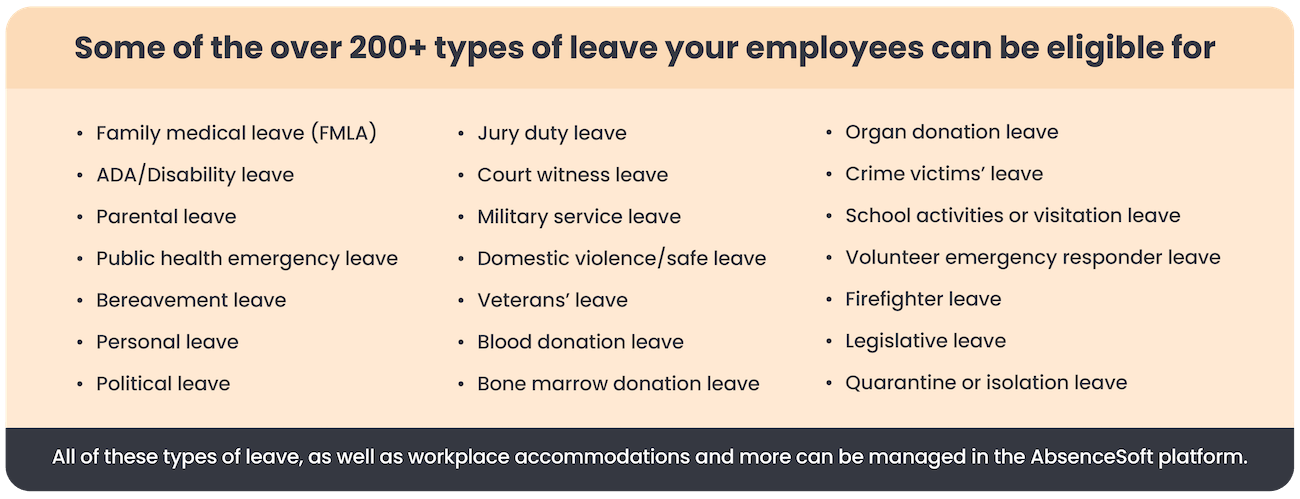The landscape of laws surrounding leave and workplace accommodations is growing more complex every day. The number of requests for leave and workplace accommodations are on the rise across industries and companies of all sizes. All of this means that it is getting easier for well-meaning HR teams to find themselves out of compliance with one or more laws or regulations, facing an EEOC or DOL audit.
To avoid an audit — or at least be fully prepared to respond to one — it’s important to make sure every single leave and accommodations request is handled the right way. To build a solid foundation for handling requests compliantly, you need to address the three P’s: policies, processes, and procedures. In this blog, we’ll look at best practices for all three, and actionable steps you can take to improve HR compliance.
#1. Make sure you have policies that account for every leave and accommodations law
There are numerous laws that cover both leaves of absence and workplace accommodations. While it may be time-consuming, the best way to stay compliant is to make sure you have policies in place that cover every leave and accommodations law that could apply to your employees. If you have employees in multiple states, remember that they could be covered by their state’s paid leave laws, in addition to the Family and Medical Leave Act (FMLA) and your own organization’s policies. The state leave law landscape is constantly evolving, so staying on top of it is critical.
If you don’t have those policies in place yet, there are numerous HR and legal expert resources you can consult, whether by hiring a consultant or researching online. At AbsenceSoft, we provide a free quarterly webinar called “Live with Legal,” hosted by legal experts, just to help leave community members stay on top of these laws. Another strategy for staying on top of state laws is to leverage leave software that is automatically updated by an in-house team from the provider, so the system can calculate eligibility correctly from day one.
By taking the time to ensure you have considered each applicable law, and creating an internal policy for managing it, you have made the critical first step in avoiding an audit. Every workplace is different, and there are no “one size fits all” policies, so you’ll need to take the time to make sure your policies reflect your work culture, organizational requirements, and more. You will also want to regularly audit your policies to make sure each regulation is covered, and that they are working well for both your HR team and the employee base.

#2. Make sure your policies are applied fairly and consistently to every employee
Once you’ve created and implemented your policies, you need to make sure they are applied fairly and consistently to be as compliant as possible.
Preferential treatment, inconsistent decision-making, or not granting an employee what they are entitled to are all common sources of audits and lawsuits.
Any employee who is requesting a leave of absence or an accommodation with the HR team should ideally have the same experience every time – over and over again. It is especially important to be sure that “similarly situated” employees receive the same treatment. For example, let’s say one employee who just gave birth is granted intermittent leave to manage postpartum depression, and then two months later another employee makes a similar request, and gets denied. This type of inconsistency puts your organization at a very high risk of a lawsuit.
To ensure a standard, equitable, and repeatable experience, leave and accommodations management technology can be hugely helpful. Technology can prompt leave and accommodations team through a standardized process, ensuring every request is acknowledged, documented, and tracked. Employee self-service portals equalize the request process even further, making sure all employees use the same system and follow the same request process.
#3. Create supporting internal procedures and processes
Once your policies are created, it’s very important to look at how those policies are put into place. Ask yourself the following questions to verify that the proper internal procedures are in place.
- What is the process that an employee must go through when they go to make a request under our leave and accommodations policies?
- Do managers know how to respond properly to an incoming request from the employees they are supervising?
- Are employees being directed to the right HR resources when they need to take a leave of absence or require an accommodation to do their job?
By having the well-considered procedures and processes in place to make sure your policies are followed, you will make sure everyone – HR and employees – are on the same page.
It also really helps to make it easy for an employee to file a complaint or raise a concern internally, as counterintuitive as it seems. If employees feel comfortable sharing their concerns internally, it can stop them from going outside the organization to file a complaint.
The more an employee can raise and resolve issues around leave and accommodations within the organization, the less likely your organization will be audited or sued.
When you are sharing your policies and procedures internally, make sure they are worded in a way that employees truly understand. You don’t want to share a bunch of legalese memos that “check the box” for minimum requirements by law – you open yourself up to a lawsuit if people can’t understand their responsibilities. In 2022, an organization lost a lawsuit because their FMLA call-in procedure was so convoluted that their own HR team couldn’t figure it out when they were asked to testify.
Conclusion
Avoiding a DOL or EEOC audit is not easy or simple, but it is very possible with the right approach. Setting aside the time and effort to make sure you have the right policies in place, and well-considered processes and procedures can go a very long way to avoiding a lawsuit. If you’d like to watch a deep dive on avoiding and responding to audits, you can register for our free webinar replay: “DOL and EEOC Audits, They’re Not that Scary.”
Leave and accommodations management technology can be a big help when it comes to creating, tracking, and streamlining your policies, processes, and procedures. Automation can help you calculate eligibility for numerous policies in seconds. You can create templated communications that can be customized in a few clicks, sending each employee exactly what they need to know so they can easily follow your process. Having a centralized platform that stores and documents every request, communication, and decision means that cases don’t fall through the cracks. It also means your team won’t have to spend hours digging through files if an audit does occur.
If you’d like to learn more about AbsenceSoft and how it can help keep you compliant, schedule a demo today.

